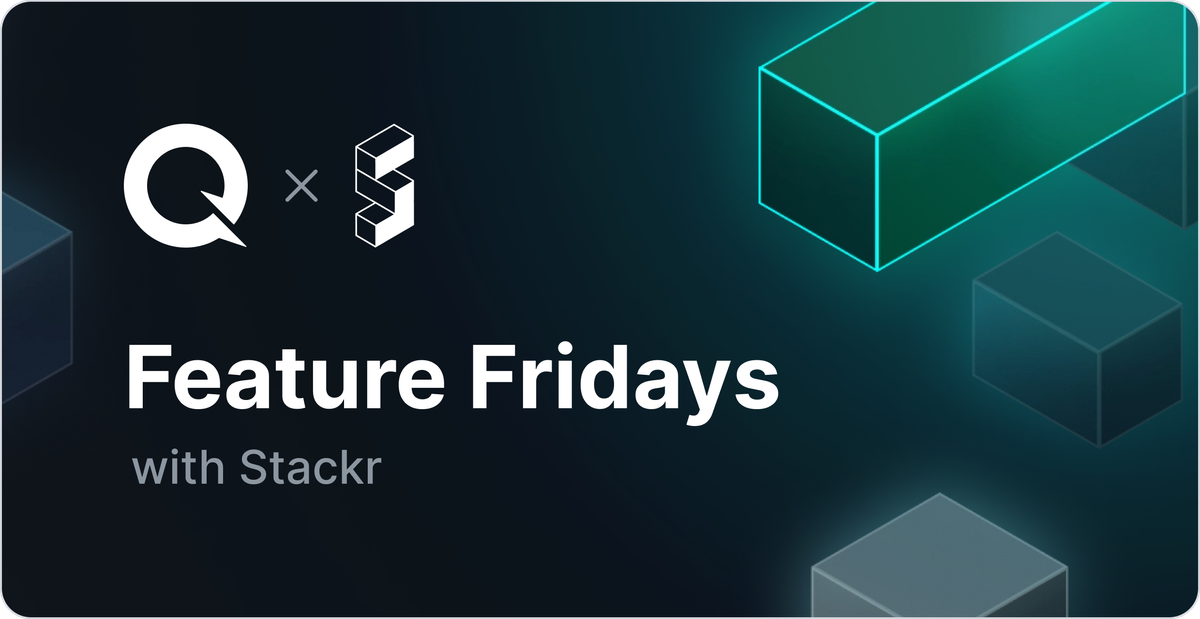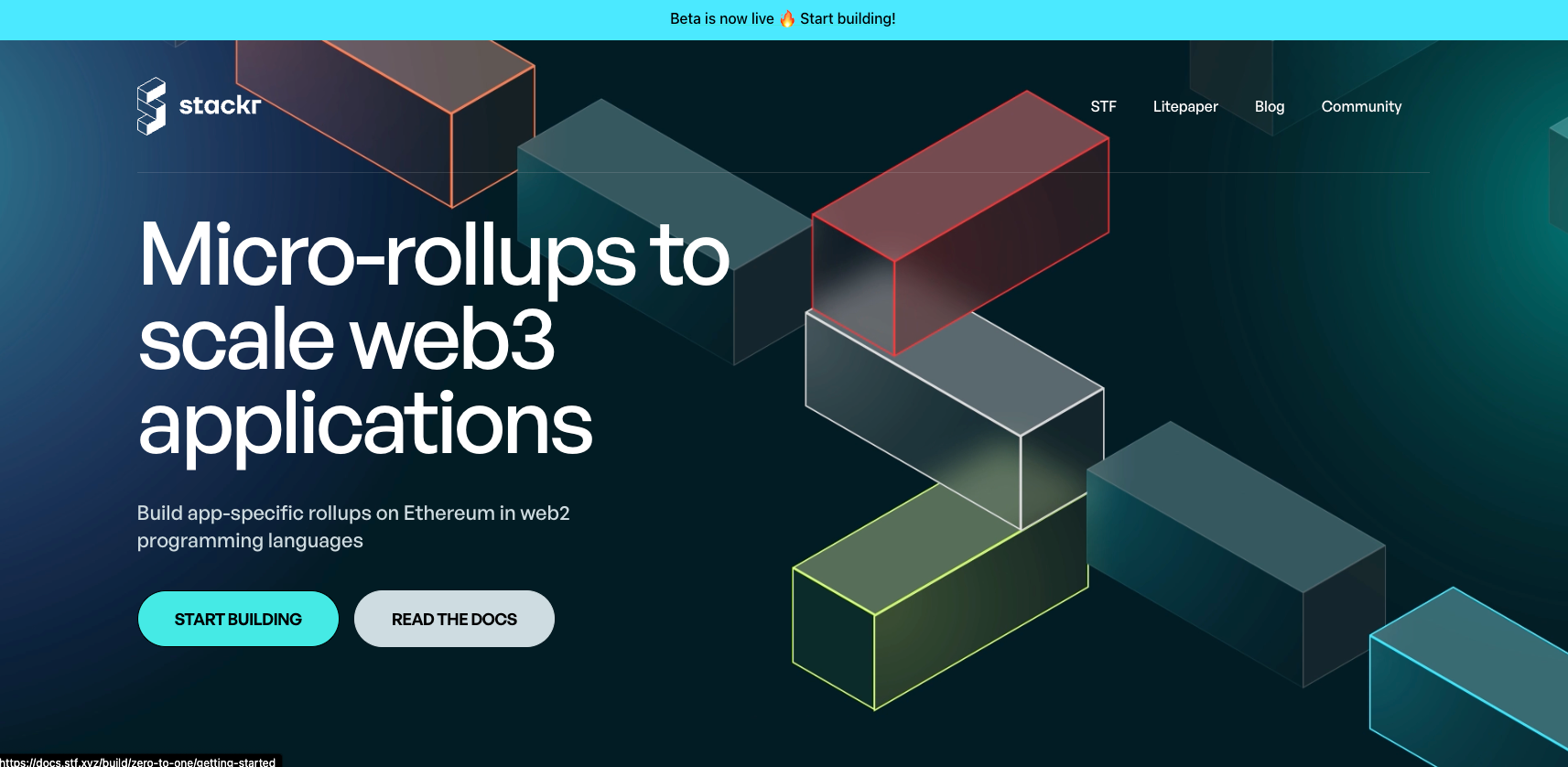Feature Fridays: Stackr
Stackr is simplifying the blockchain ecosystem by empowering developers with a comprehensive toolkit for building app-specific rollups.

Welcome back to Feature Fridays! This week, we’re excited to spotlight Stackr Labs, a groundbreaking platform simplifying app-specific rollup development for Web3. Founded by Kautuk, former research engineer at the Ethereum Foundation, Stackr is revolutionizing how developers build custom appchains with its powerful SDK. With a team dedicated to innovation, Stackr is lowering the barriers for developers to create scalable, efficient blockchain applications.

Q & A with Stackr 👇
Could you introduce yourself by sharing your name, prior experience, and current role within your company? Additionally, please briefly explain your company's mission and what it offers to its customers.
My name is Kautuk, I am the founder of Stackr Labs, where I oversee both product and business operations alongside an incredible team of engineers. Before this, I worked as a research engineer at the Privacy and Scaling Explorations group within the Ethereum Foundation and briefly contributed to Livepeer's protocol.
At Stackr, our mission is to simplify and accelerate the development of app-specific rollups by offering an intuitive and comprehensive toolkit. Our goal is to lower developers' barriers, allowing them to quickly experiment with various app chain designs and create innovative solutions with superior user experiences.
Stackr offers an SDK, a powerful toolkit for building lightweight and customizable app-specific rollups. The SDK streamlines the development of L2 AppChains by allowing developers to create custom-state machines tailored to their application’s specific needs, resulting in more efficient, lightweight, and cost-effective applications. Written in TypeScript, Stackr’s SDK is designed to reduce the learning curve for web2 developers, making it easier for them to transition into web3 development and quickly build innovative blockchain solutions.
How has your company grown and changed since its inception, and what do you have planned for its future?
Since its inception, Stackr has evolved from an experimental concept into a comprehensive framework for building app-specific rollups. What started as a hackathon project has become a full-fledged platform, taking about a year to reach a publicly available release. Initially, it was driven by solo development, but today, Stackr is supported by a talented engineering team. Our team of 7 is expanding as we prepare for the next growth phase.
With the product now ready and attracting significant demand, our focus is shifting toward meeting this growing interest while scaling through strategic marketing and business development efforts.
Moving forward, we will continue advancing state isolation techniques, rollup interoperability, support for various cryptography schemes, make the framework available on more platforms, integrate advanced zk-proof systems, and expand peer-to-peer application support. At the core of our growth strategy is ensuring developers have a seamless experience with our tools, empowering them to innovate and experiment easily.
What inspired you to develop Stackr, and how did you conceive?
The inspiration for Stackr came from my work on the Hubble Rollup project at PSE in early 2020-22 and my involvement in the Ethereum ecosystem. The Hubble project was a key inspiration for Stackr. Hubble was one of the first implementations of an app-specific rollup, even before "rollup" became widely recognized in the blockchain space. It demonstrated the potential of rollups as a way to scale applications on Ethereum by providing a bespoke execution environment that could do just 1 thing - token transfers - but could do it 1000x more efficiently than the next best option.
Unfortunately, Hubble was sunset, but its vision stuck with me. I strongly believed that as blockchain projects matured, there would be a growing demand for appchains, as developers would seek more control over their infrastructure and the ability to tailor it to their unique needs.
That belief in the future of app-specific rollups drove me to pursue Stackr. I wanted to create a toolkit that would allow developers to easily build and customize their own appchains, lowering the barriers to entry and enabling more projects to scale effectively on Ethereum. Today, with the growing adoption of rollups and modular blockchains, it’s clear that the demand for app-specific infrastructure is on the rise, and Stackr is well-positioned to meet that need.
Can you provide insight into Stackr’s progress by sharing any metrics or milestones indicating its traction?
Stackr has made remarkable progress since its inception in Sept 2022, evolving into a fully operational framework. A major milestone came during ETH India 2023, where we hosted a hackerhouse that brought together 40 developers from 11 teams to test the alpha version of our SDK. Out of over 500 teams, 4 of the teams using Stackr’s SDK placed in the top 10, showcasing the effectiveness and real-world practicality of our product. This event validated our work product's effectiveness and real-world practicality, demonstrating that our solution empowers developers to succeed in highly competitive environments.
Building on that momentum, April 2024 marked the release of our litepaper, which was widely praised for clearly outlining our vision for app-specific rollups. This release solidified Stackr’s position in the space and attracted further attention from developers and the broader blockchain community. In tandem, we rolled out the public beta version of the Stackr SDK, incorporating valuable feedback from the alpha release, which significantly improved the developer experience and SDK functionality.
We have also been actively engaging with our community through blog posts, significantly and use cases built using Stackr.Proof of Gameplay” that allowed devs to build fully on-chain verifiable games easily, sharing media attention.
Partnerships have played a critical role in our growth too. A key collaboration was with Avail, where we hosted their football tournament on a custom rollup built using Stackr. This partnership showcased the real-world applications of our technology and how it can be tailored to specific needs. Additionally, we’ve secured several other partnerships, which will be announced soon, signaling the increasing demand for Stackr in the blockchain ecosystem.
Finally, as a continuation of our developer engagement, we recently sponsored the ETHOnline 2024 hackathon, where we expect to see a significant number of projects built using Stackr.
How does your company utilize QuickNode, and what benefits does it bring to your business operations?
We utilize QuickNode for its fast and reliable RPCs, which are critical to supporting our verifier layer, (aka Vulcan). This ensures the seamless and dependable delivery of events from Micro-rollup's AppInboxes and provides a fail-proof mechanism for submitting app blocks and batches in our network architecture. QuickNode’s high-performance infrastructure helps us maintain efficiency and reliability, which is essential for our app-specific rollups, where any delays or issues could affect the overall performance.
Additionally, we leverage QuickNode’s multi-chain endpoint to streamline our operations by accessing multiple blockchain networks through a single interface. This significantly simplifies our development process, allowing our team to focus on core functionalities rather than managing complex node infrastructure across different chains. It helps us scale rapidly as we add support for more blockchain environments.
Looking ahead, we’re excited about the upcoming innovations from QuickNode, particularly the development of RPC with DA Light Clients. This will further enhance our system by offering more decentralized and efficient data availability layers, aligning with our vision of building lightweight and scalable rollups.

About QuickNode
QuickNode is building infrastructure to support the future of Web3. Since 2017, we've worked with hundreds of developers and companies, helping scale dApps and providing high-performance access to 40+ blockchains. Subscribe to our newsletter for more content like this, and stay in the loop with what's happening in web3!





